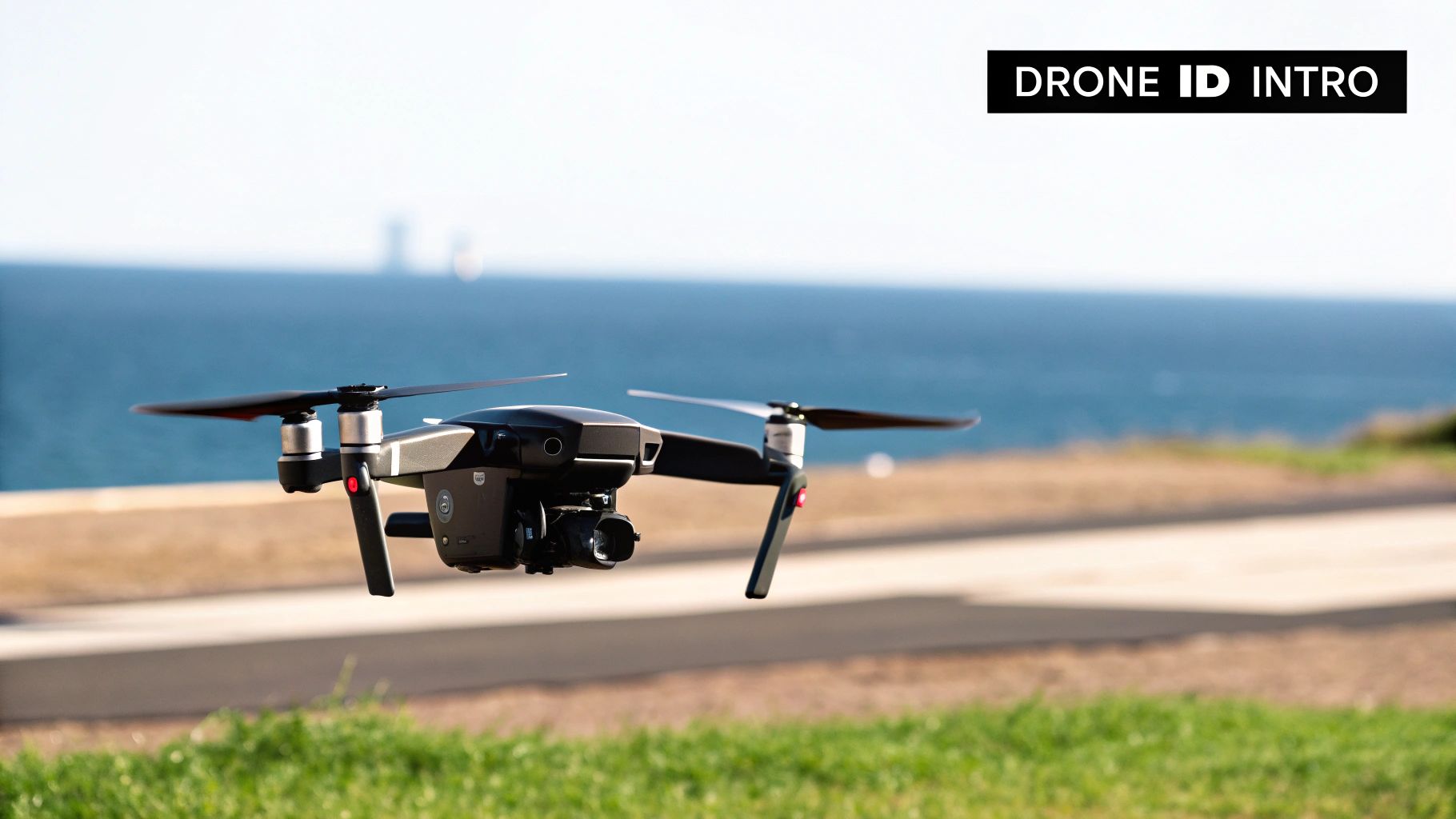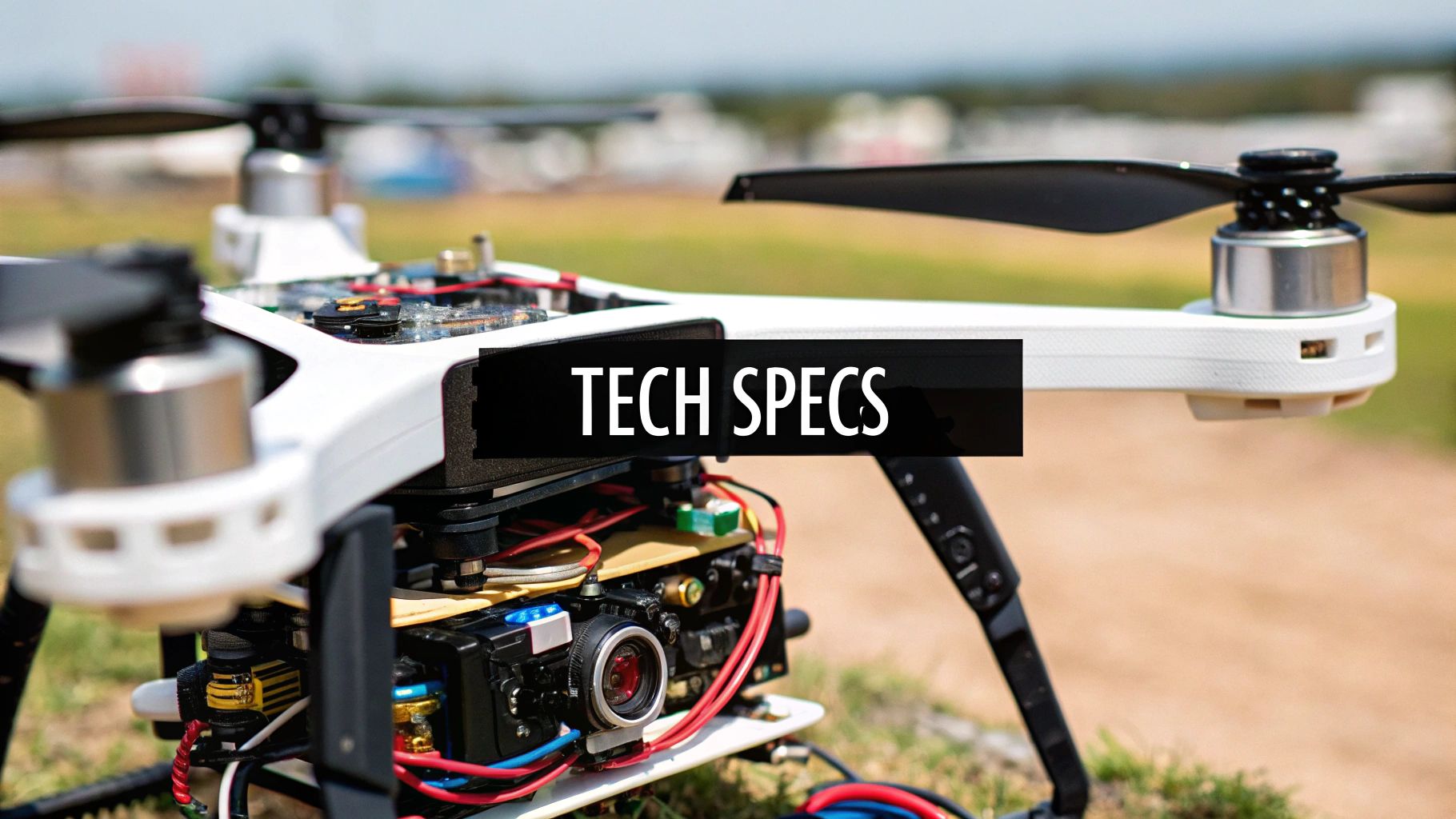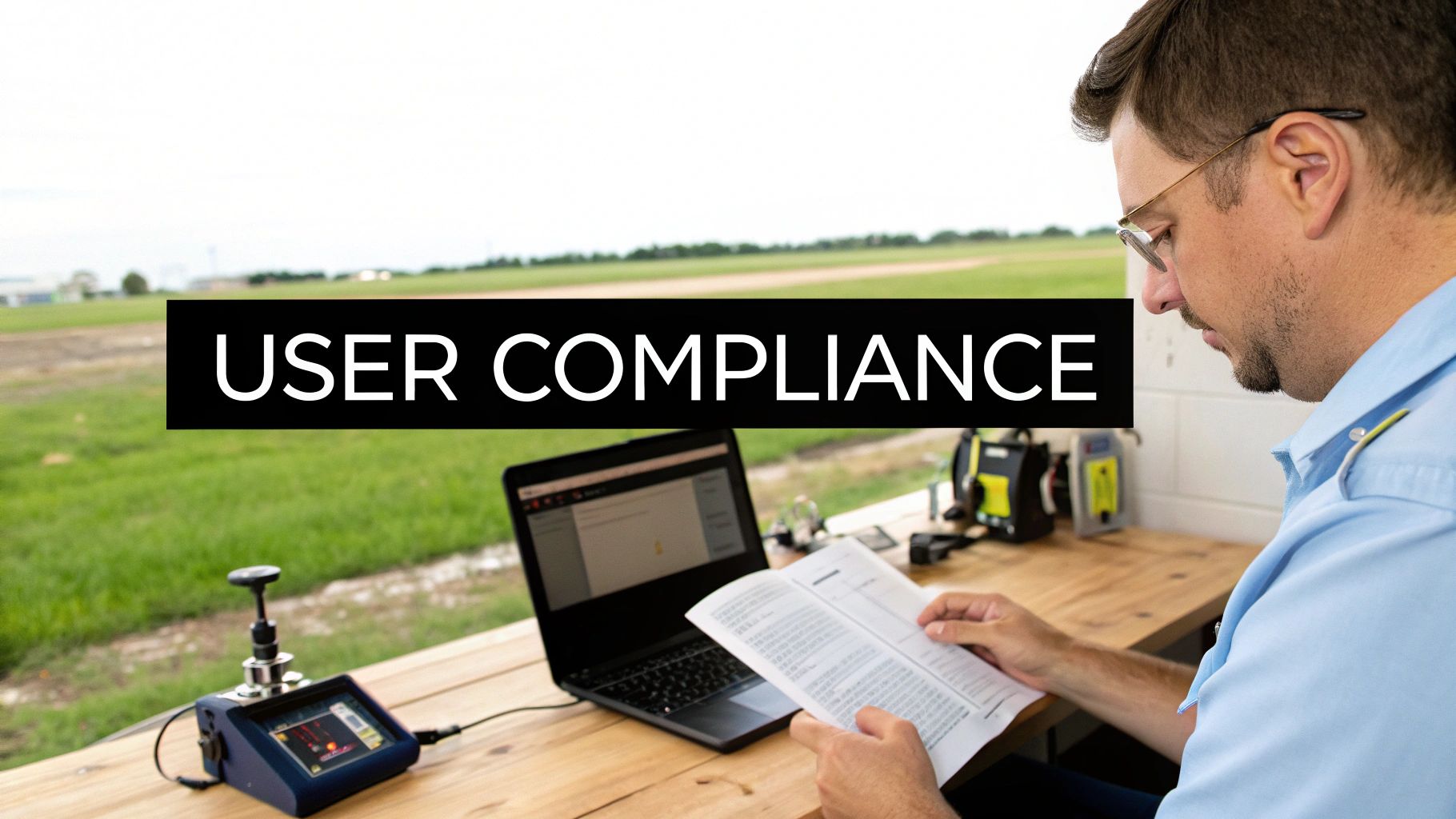Drone Remote ID Requirements: Quick Compliance Tips
- A.E. Williams

- Apr 14
- 13 min read
Navigating Drone Remote ID: What Every Pilot Needs to Know

Drone Remote ID is often referred to as a "digital license plate" for unmanned aircraft. It’s a system designed to improve airspace safety and security. But what exactly does this mean for drone pilots? This section will cover the basics of drone Remote ID requirements, guiding you through this evolving technology. For a complete overview, check out this helpful guide: Drone Remote Identification: Your Compliance Guide.
Understanding the Purpose of Drone Remote ID
The main purpose of Remote ID is to make drones readily identifiable in the airspace. This allows authorities and other airspace users to see who is operating a drone, its current location, and its intended flight path. This transparency significantly increases safety by promoting better situational awareness and helping to prevent conflicts. It also strengthens security by allowing authorities to respond swiftly to potential security risks or illegal drone activity.
What Information Is Broadcast?
Remote ID systems transmit vital data points about the drone and its operator. Here’s a breakdown:
Drone Location (latitude, longitude, altitude): This provides real-time tracking of the drone's position.
Drone Velocity (speed and direction): Understanding the drone’s speed and direction helps predict its trajectory.
Operator Location: The location of the person controlling the drone is also transmitted.
Drone Identification: A unique identifier, similar to a registration number, distinguishes each drone.
This information helps authorized parties identify drones operating nearby and pinpoint the operator's location.
The Impact of Global Regulations on Drone Operations
Implementing Remote ID requirements marks a significant change in drone operations globally. For instance, as of January 1, 2024, the EU requires all drones operating in specific categories to have Remote ID systems. This applies to drones weighing over 250 grams flying below 120 meters in the Open or Specific categories. This mandate enables real-time tracking of drone locations and identities.
The broadcast data, including the drone's location, velocity, and operator location, enhances safety and accountability. Using Direct Remote ID (DRI) via Wi-Fi or Bluetooth provides broad accessibility while respecting pilot privacy. This highlights the growing emphasis on transparency and security in the drone industry. For a more detailed look, see: Learn more about drone Remote ID in 2024. These regulations impact various drone operations, from recreational flights to complex commercial missions. Understanding these rules is essential for all drone pilots.
FAA Remote ID Timeline: Meeting Compliance Deadlines

Understanding the FAA Remote ID timeline is crucial for all drone pilots. Meeting the deadlines ensures your drone operations remain legal and uninterrupted. This section breaks down the important dates and offers guidance for achieving compliance.
Key Dates and Requirements
The FAA Remote ID rule uses a phased approach. Understanding these phases helps drone operators prepare. The final compliance deadline for Remote ID in the United States is March 16, 2024. This means all drones requiring registration (generally those over 250 grams used recreationally or commercially) must comply.
This mandate affects almost 1 million registered drones in the United States, out of approximately 3.5 million total drones in use. Drones requiring registration must have built-in Remote ID or be equipped with a Remote ID broadcast module. The FAA's push for Remote ID is part of a larger strategy to integrate drones safely into the National Airspace System (NAS). This focuses on enhanced security and safety by making drone operations more transparent. However, challenges like privacy concerns and supply chain issues have made the rollout complex. You can find more detailed statistics here: Drone Manufacturers and FAA Remote ID Requirements. This crucial step improves safety and accountability within the NAS.
Compliance Methods: Choosing The Right Path
Drone operators have several ways to meet Remote ID requirements. The best method depends on your drone and operational needs.
Standard Remote ID: Drones built with integrated Remote ID broadcast capabilities comply automatically.
Remote ID Broadcast Modules: Adding a broadcast module is a solution for drones without built-in Remote ID.
Flying at an FAA-Recognized Identification Area (FRIA): Operating within a designated FRIA allows flight without Remote ID equipment, but restricts operations to those specific locations.
To help you choose the right path, we've created a comparison table outlining the pros and cons of each method:
Introducing a table that breaks down the three main FAA Remote ID compliance methods, making it easy to compare and choose the best fit for your drone operations.
FAA Remote ID Compliance Methods Comparison
Compliance Method | Description | Advantages | Limitations | Best For |
|---|---|---|---|---|
Standard Remote ID | Built-in Remote ID capability within the drone. | Simplest method; no additional equipment or modifications required. | Only available on newer drone models. | New drone purchases; pilots seeking the easiest solution. |
Remote ID Broadcast Modules | External module that broadcasts Remote ID information. | Cost-effective solution for existing drones. | Requires installation and maintenance; adds weight and potential interference. | Existing drone fleets; budget-conscious pilots. |
Flying at an FAA-Recognized Identification Area (FRIA) | Operating at designated flying areas approved by the FAA. | No Remote ID equipment required. | Restricts flight operations to specific locations. | Pilots operating solely within FRIA boundaries. |
This table clearly highlights the trade-offs between convenience, cost, and operational flexibility. Choosing the right method is crucial for seamless compliance.
Evaluating Your Drone Fleet
Assessing your drone fleet is the first step toward compliance. Figure out which drones require Remote ID and the best method for each. Consider factors like drone age, usage frequency, and budget. Retrofitting older drones may be more cost-effective than buying new compliant models. However, for frequent flyers, investing in drones with built-in Remote ID might be a better long-term investment.
Consequences of Non-Compliance
Failing to meet the Remote ID deadline has significant consequences. These include potential fines, flight restrictions, and even legal action. Staying informed and taking proactive steps to comply is essential.
Strategic Compliance Management
For operators with multiple drones or complex missions, a strategic approach is vital. Develop a clear compliance plan that includes:
Inventory Assessment: List your drones and their current Remote ID status.
Compliance Method Selection: Choose the right method for each drone.
Implementation Timeline: Create a schedule for achieving compliance before the deadline.
Documentation: Keep detailed records of your compliance work.
A proactive and organized approach will ensure a smooth transition to the new Remote ID regulations. Learn more: Read also: How to Master Drone Operations.
Decoding Remote ID Broadcast Technology Requirements

Operating a drone with Remote ID isn't just about attaching a module; it's about understanding the technology behind it. This knowledge can save you headaches and expenses down the line. Let's explore the technical details and how they impact your drone flights.
Understanding Broadcast Power and Transmission Protocols
Remote ID systems transmit data wirelessly, similar to a radio broadcast. Broadcast power affects signal strength and range. More power means greater range, but it also uses more battery. The transmission protocol determines how data is formatted and transmitted. Think of it as the language spoken between the drone and receivers. These technical factors directly influence your drone's flight time and the Remote ID system's reliability.
Decoding Required Data Elements
Remote ID systems transmit specific, required data, not just random information. These essential data points include:
Drone Identification: A unique identifier, like a serial number or session ID.
Location Data (latitude, longitude, altitude): Real-time positional data of the drone.
Velocity Data (speed and direction): Helps in predicting the drone's trajectory.
Operator Location (for some jurisdictions): Required in some areas for tracking purposes.
Timestamp: Records when the data was captured.
Emergency Status: Signals if the drone is experiencing an emergency.
These data elements allow authorities and other airspace users to track and identify drones, enhancing safety and security for everyone.
Wi-Fi, Bluetooth, and Other Broadcast Technologies
Different broadcast technologies are used for Remote ID, each with its own strengths and weaknesses. Wi-Fi offers high bandwidth and range but can be power-hungry. Bluetooth uses less power but has a limited range. Other specialized technologies are also being developed. Knowing these differences is vital for choosing the right Remote ID system for your needs. For instance, long-range flights might benefit from Wi-Fi, while shorter flights could use Bluetooth. This choice significantly impacts your drone's battery life and operational range.
Verifying Your Equipment and Prioritizing Selection
Confirming your drone's compliance with Remote ID requirements is crucial. Check your drone's specifications and the manufacturer's documentation. When selecting a Remote ID module, consider factors like compliance with your local rules, ease of installation, power usage, and its effect on drone performance. Staying informed about the latest advancements in Remote ID technology is also recommended, as these changes can impact future requirements and offer improved solutions. Learn more about global drone regulations.
Remote ID Around The World: Navigating Global Requirements

Drone Remote ID requirements are a complex and evolving aspect of drone operation. For drone pilots looking to operate internationally, understanding these varying regulations is vital. This section offers a comparison of Remote ID requirements across different regions, highlighting the key differences and what they mean for drone operators.
Comparing FAA and EASA Regulations
Two of the most prominent regulatory bodies for drones are the Federal Aviation Administration (FAA) in the United States and the European Union Aviation Safety Agency (EASA). Both have implemented Remote ID, but their approaches have distinct differences.
The FAA mandates Remote ID for all registered drones over 250 grams, with a compliance deadline of March 16, 2024. EASA's implementation date is January 1, 2024, and exempts some very small or tethered drones. These differences in timelines and drone classifications are important for international operators to understand.
Furthermore, the specific data requirements for each system vary. Both require basic information like drone identification and location. However, there are differences in additional data requirements such as operator location and emergency status reporting. Drone operators need to verify their equipment’s compatibility if they plan to operate under both the FAA and EASA regulations.
Exploring Requirements in Other Key Markets
Outside of the U.S. and Europe, other countries are developing their own Remote ID frameworks. Canada, Australia, and several Asian countries are creating rules specific to their airspace and operational contexts.
For instance, some countries may prioritize operator registration, while others have stricter rules for flying near sensitive areas. These variations can significantly impact international drone operations, requiring careful research and compliance planning.
Practical Implications for International Drone Operators
The lack of global standardization for drone Remote ID presents practical challenges. Drone operators flying in multiple jurisdictions must ensure compliance with each region's specific rules. This may include using different Remote ID modules, adjusting flight procedures, and maintaining detailed records.
One major challenge is the potential need for multiple Remote ID setups. A drone compliant with FAA regulations may not satisfy EASA standards. This can lead to increased costs and complexity for international operations.
To help illustrate these global differences, the following table provides a comparison of Remote ID requirements across various regions.
Global Remote ID Requirements Comparison
Region/Country | Implementation Date | Affected Drones | Required Data Elements | Compliance Methods | Penalties |
|---|---|---|---|---|---|
United States (FAA) | March 16, 2024 | >250g | Drone ID, Location, etc. | Broadcast, Network | Fines, Restrictions |
European Union (EASA) | January 1, 2024 | Most drones (exceptions apply) | Drone ID, Location, etc. | Broadcast, Network | Fines, Restrictions |
Canada | Varies by drone type | Varies by drone type | Drone ID, Location, etc. | Broadcast, Network | Fines, Restrictions |
Australia | Phased implementation | Varies by drone type | Drone ID, Location, etc. | Broadcast, Network | Fines, Restrictions |
Japan | Varies by area | Varies by area | Drone ID, Location, etc. | Primarily Network | Fines, Restrictions |
This table highlights the variation in implementation dates, affected drone types, and compliance methods, demonstrating the need for careful research and preparation when operating internationally.
Strategies for Adapting to Multiple Regulatory Frameworks
Drone operators can employ several strategies to manage these complexities:
Research: Thoroughly investigate the Remote ID rules of each country where you intend to fly.
Equipment Flexibility: Select Remote ID modules or drones that are adaptable to multiple regulatory frameworks.
Operational Planning: Create procedures to adjust your flight operations based on local rules.
Documentation: Maintain detailed flight records and compliance documentation for each region.
By staying informed and adopting flexible strategies, international drone operators can successfully manage the global Remote ID landscape and ensure safe and legal flights wherever their operations take them.
Achieving Remote ID Compliance: Your Step-by-Step Guide
Getting your drones compliant with Remote ID rules might feel like a big task, but a structured approach makes it much easier. This guide breaks down the process into practical steps based on real-world experiences, helping you figure out your specific needs, assess your current drones, and find the most efficient and cost-effective solutions.
Determining Your Compliance Needs
First, do you even need Remote ID? As of March 16, 2024, most drones over 250 grams used recreationally or commercially in the U.S. will require it. The FAA website has all the specifics and exemptions. Remember, rules vary globally, so research the regulations wherever you plan to fly. This first step can save you unnecessary time and money.
Assessing Current Equipment Capabilities
Once you know you need Remote ID, check your drone’s specs and manufacturer information. See if it has built-in Remote ID, often called Standard Remote ID. If not, don't worry! Remote ID Broadcast Modules are readily available. These external modules transmit the required data, and they're usually cheaper than buying a new drone. Lastly, if you only fly at a specific, approved location, an FAA-Recognized Identification Area (FRIA) might work. FRIAs allow flight without Remote ID equipment. Understanding these options lets you make smart decisions about your existing gear.
Selecting and Installing Broadcast Modules
If you need a broadcast module, pick one that's compatible with your drone model and follows the rules in your area. JAB Drone offers helpful reviews of various modules. Proper installation is essential. Follow the manufacturer's instructions precisely to ensure the module doesn't interfere with your drone’s other parts or affect its flight. It's similar to adding a new component to your computer – doing it correctly ensures everything runs smoothly.
Testing and Validation
After installing a module, test it thoroughly. Make sure it transmits the right data and works as expected. It's like a musician tuning their instrument – testing confirms everything is functioning correctly. Include Remote ID checks in your pre-flight routine for every flight. This simple step can prevent potential problems during your drone operations.
Documentation and Maintenance
Keep good records of your Remote ID setup, including module details, installation dates, and test results. This documentation proves your compliance and is useful for troubleshooting. Like keeping maintenance records for your car, thorough documentation helps with future compliance checks and any repairs or replacements.
Troubleshooting Common Broadcast Issues
You might run into problems with your Remote ID broadcast occasionally. Knowing common issues and their solutions helps you get back in the air quickly. The JAB Drone community forum is a great place to find help and advice from other pilots. This shared knowledge base is a valuable resource. Being prepared for potential hiccups is a key part of smooth drone operations.
Balancing Privacy Concerns With Remote ID Compliance
Many drone operators have legitimate privacy concerns regarding Remote ID. This section directly addresses these concerns, exploring what information is publicly accessible, who can access it, and the current safeguards in place.
What Information Is Publicly Available?
Remote ID broadcasts specific data about your drone and, in some cases, you as the operator. This typically includes the drone's location, altitude, velocity, and a unique identifier. Some jurisdictions also require broadcasting the operator's location. Think of it like a navigation app knowing your car's location and speed—real-time data is shared, but not necessarily your personal details.
Who Can Access This Data?
Authorized parties, like law enforcement and aviation authorities, can easily access Remote ID data. This access is critical for maintaining airspace safety and security. However, the public nature of some broadcasts raises understandable privacy questions. Anyone with a Remote ID receiver could theoretically access the broadcast data, but authorities primarily use the information for safety and regulatory purposes.
Existing Protections and Safeguards
Regulations include provisions designed to mitigate privacy risks. For example, broadcasting a session ID instead of a permanent serial number helps protect the drone's identity. Data retention policies also limit how long this information is stored. These safeguards balance the need for transparency with individual privacy rights. Just as with any publicly broadcast information, awareness and understanding are key.
Real-World Implications for Operational Security
Remote ID does introduce potential security risks. Publicly accessible flight paths could expose sensitive operations, such as infrastructure inspections or private security patrols. Understanding these risks allows operators to develop mitigation strategies. This might involve careful flight path planning, especially in sensitive areas, considering the potential visibility of your operations. You might be interested in: Learn more about global drone regulations.
Maintaining Privacy While Remaining Compliant
Balancing privacy and compliance necessitates a proactive approach. Operators can use features like session IDs, plan flight paths meticulously, and stay informed about data retention policies. Engaging in ongoing regulatory discussions also helps shape future privacy protections. Contributing to public consultations on Remote ID rules, for instance, ensures legitimate privacy concerns are addressed.
Organizational Approaches and Client Education
Organizations using drones for sensitive missions should establish clear internal policies about data handling and flight planning. Educating clients about the implications of Remote ID for their operations is equally important. Clear communication and transparency build trust and ensure everyone understands the privacy considerations. This proactive communication is essential for responsible drone operations.
Participating in Regulatory Discussions
The regulatory landscape for Remote ID is constantly changing. Participating in these discussions is vital for operators who value their privacy. By voicing your concerns and contributing to policy development, you can help create a regulatory environment that balances transparency and legitimate privacy interests. This participation ensures future regulations reflect the needs of all stakeholders. Staying informed and engaged is crucial for all drone operators.
The Future of Drone Remote ID: What's Coming Next
As Remote ID systems become the industry standard, what lies ahead for drone operators? This section explores the future of drone Remote ID requirements, examining potential regulatory changes, evolving technology, and how these advancements will affect drone operations.
Anticipating Regulatory Adjustments
Current drone Remote ID requirements are a significant step toward safer airspace integration. However, regulations are constantly evolving. As drone technology and operations grow more complex, we can expect adjustments to Remote ID rules. These changes could include stricter limitations on flight near sensitive areas or updates to data broadcast requirements.
For example, future regulations may require additional data points, such as drone payload information, or more frequent location updates. This means staying up-to-date on proposed changes is essential for maintaining compliance.
Technological Advancements Simplifying Compliance
Technology is constantly evolving, including Remote ID systems. We can expect improvements in broadcast technology, simplifying compliance and increasing efficiency. Smaller, lighter, and more energy-efficient broadcast modules, for instance, could lead to longer drone flight times.
Furthermore, advancements in network identification, which transmits data through cellular or satellite networks rather than direct broadcasts, could benefit long-range operations. These technological improvements have the potential to reshape drone remote ID requirements, making them more seamless and less obtrusive.
Integration with Unmanned Traffic Management (UTM)
Remote ID is a critical component of Unmanned Traffic Management (UTM) systems. UTM functions like air traffic control for drones, managing drone flights in low-altitude airspace. As UTM systems develop, Remote ID data will become increasingly important for coordinating drone traffic, preventing collisions, and enabling more complex drone operations. This integration will further improve airspace safety and support the growth of the drone industry. You can learn more at JAB Drone's event page sitemap.
Emerging Technologies Reshaping Requirements
Emerging technologies like advanced broadcast systems and network identification could significantly impact drone remote ID requirements. Network-based Remote ID, for example, could allow for more accurate tracking and management of drone flights, especially beyond visual line of sight (BVLOS). This could lead to regulatory changes concerning BVLOS operations. Keeping up with these technological trends is vital.
Practical Considerations for Future-Proofing Your Operations
Forward-thinking operators should proactively prepare for future drone remote ID requirements:
Equipment Investments: Evaluate your drone fleet's adaptability to future Remote ID technologies.
Training Programs: Ensure your pilots understand evolving Remote ID regulations and technologies.
Operational Planning: Develop adaptable operational procedures to accommodate changing requirements.
By considering these factors, you can ensure your drone operations remain compliant and efficient as Remote ID continues to evolve. This proactive approach will benefit you in the long term, minimizing future costs and ensuring smooth operation.
Ready to take your drone operations to the next level? Explore the latest drone technology, reviews, and insights at JAB Drone. We provide the knowledge and resources you need to stay ahead in the dynamic world of drones.




Comments